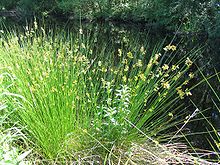Juncaceae
This article needs additional citations for verification. (April 2017) |
| Juncaceae | |
|---|---|

| |
| Juncus effusus | |
| Scientific classification | |
| Kingdom: | Plantae |
| Clade: | Tracheophytes |
| Clade: | Angiosperms |
| Clade: | Monocots |
| Clade: | Commelinids |
| Order: | Poales |
| Family: | Juncaceae Juss.[1] |
| Type genus | |
| Juncus | |
| Genera | |
| |

| |
| Species richness of Juncaceae | |
| Synonyms | |
| |
Juncaceae is a family of flowering plants, commonly known as the rush family. It consists of 8 genera and about 464 known species[2] of slow-growing, rhizomatous, herbaceous monocotyledonous plants that may superficially resemble grasses and sedges. They often grow on infertile soils in a wide range of moisture conditions. The best-known and largest genus is Juncus. Most of the Juncus species grow exclusively in wetland habitats. A few rushes, such as Juncus bufonius are annuals, but most are perennials. Despite the apparent similarity, Juncaceae are not counted among the plants with the vernacular name bulrush.
Description
[edit]The leaves are evergreen and well-developed in a basal aggregation on an erect stem. They are alternate and tristichous (i.e., with three rows of leaves up the stem, each row of leaves arising one-third of the way around the stem from the previous leaf). Only in the genus Distichia are the leaves distichous. The rushes of the genus Juncus have flat, hairless leaves or cylindrical leaves. The leaves of the wood-rushes of the genus Luzula are always flat and bear long white hairs.
The plants are bisexual or, rarely, dioecious. The small flowers are arranged in inflorescences of loose cymes, but also in rather dense heads or corymbs at the top of the stem or at its side. This family typically has reduced perianth segments called tepals. These are usually arranged in two whorls, each containing three thin, papery tepals. They are not bright or flashy in appearance, and their color can vary from greenish to whitish, brown, purple, black, or hyaline. The three stigmas are in the center of the flowers. As is characteristic of monocots, all of the flower parts appear in multiples of three.
The fruit is usually a nonfleshy, three-sectioned dehiscent capsule containing many seeds.
Uses
[edit]The dried pith of plants of this family is used to make a lighting implement known as a rushlight.[3]
The common rush (Juncus effusus) is called igusa in Japanese and is used to weave the soft surface cover of tatami mats.[4]
In medieval Europe, loose fresh rushes would be strewn on earthen floors in dwellings for cleanliness and insulation. Particularly favored for such a purpose was Acorus calamus (sweet flag), but despite its alternate vernacular name "sweet rush", it is a plant from a different monocot order, Acorales.[5] Up until the 1960s in Ireland, rushes were spread on the earthen floor of homes during wet weather to help keep the floor dry during periods of snow or rain, or during hot weather to keep rooms cool. Rushes used in Ireland included Juncus effusus, Juncus glaucus, and Juncus conglomeratus.[3]
The stems and leaves of Juncus kraussii were used by Indigenous Australians for fibre, for string, fishing lines, woven rugs and woven baskets. It is commonly used today for stabilisation of the banks of estuaries, around salt marshes and riparian zones next to sites developed for human use. It is also used in biofiltration systems and rain gardens.[6]
References
[edit]- ^ Angiosperm Phylogeny Group (2009). "An update of the Angiosperm Phylogeny Group classification for the orders and families of flowering plants: APG III". Botanical Journal of the Linnean Society. 161 (2): 105–121. doi:10.1111/j.1095-8339.2009.00996.x. hdl:10654/18083.
- ^ Christenhusz, M. J. M.; Byng, J. W. (2016). "The number of known plants species in the world and its annual increase". Phytotaxa. 261 (3). Magnolia Press: 201–217. doi:10.11646/phytotaxa.261.3.1. Archived from the original on 2016-07-29. Retrieved 2016-07-14.
- ^ a b O'Dowd, Anne (2015). Straw, Hay & Rushes in Irish Folk Tradition. Dublin. p. 26. ISBN 978-0-7165-3311-5. OCLC 933524857. Archived from the original on 2022-03-05. Retrieved 2022-04-06.
{{cite book}}: CS1 maint: location missing publisher (link) - ^ "Structure of Tatami". kyo-tatami.com. Motoyama Tatami Shop. 2015-06-28. Archived from the original on 2018-03-19. Retrieved 14 June 2021.
- ^ Burton, Alfred. Rush-bearing: An Account of the Old Custom of Strewing Rushes: Carrying Rushes to Church; The Rush-Cart; Garlands in Churches; Morris-Dancers; The Wakes; The Rush. Manchester: Brook & Chrystal, 1891; pp. 1-12
- ^ "Juncus kraussii". Botanic Gardens of South Australia. Archived from the original on 16 January 2023. Retrieved 24 November 2020.
External links
[edit]- Information and pictures
- . The American Cyclopædia. 1879.
- . Encyclopædia Britannica (11th ed.). 1911.
